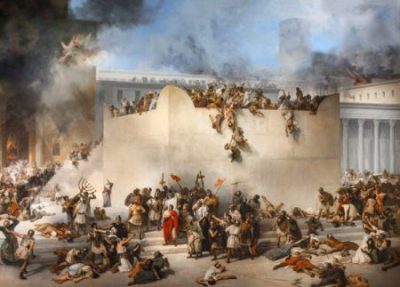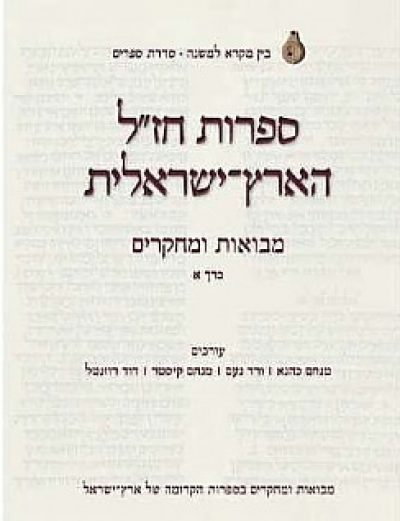The term Eretz Yisrael
Israel is the collective name of the Jewish people, descendants of the tribes established by the sons of Jacob, who was also known as Israel. The term Eretz Yisrael is not geographic, rather it refers to the land of the children of Israel ארץ בני ישראל, as in Joshua 11:22 where this expanded name is used. In early biblical usage, and sometimes later, Eretz Yisrael was referred to as Eretz Ha-Ivrim (land of the Hebrews) (Gen. 40:15). Use of the term Eretz Yisrael began already in the Bible (II Kings 5:2) from the time the Israelite tribes began to live in the land, but became widespread only later.
The land—or parts of it—has had many other names including: Retenu (Egyptian), Canaan, Ephraim, Yehud, Yehuda, Iouda, Ioudaia, Judaea (Greek and Roman), Ar’a de-Yisrael (Aramaic), as well, of course, as Palestine, the Holy Land and Terra Sancta. It is also referred to as the Promised Land based on God’s often-repeated promise to Abraham and his descendants: “To your descendants I have given this land, from the river of Egypt as far as the great river the Euphrates. (Genesis 15:18)”
It is important to remember that Eretz Yisrael, the Land of Israel, is a philosophical, theological and halakhic (Jewish legal) concept and is not equivalent to the political State of Israel.
Boundaries of Eretz Yisrael
Eretz Yisrael is an ambiguously defined geographical area.
The most expansive definition—that of the “promise”— extends from “the river of Egypt” (probably Wadi el-Arish, not the Nile) to the Euphrates. This definition encompasses areas including the State of Israel, the West Bank (Judea and Samaria), the Gaza Strip, eastern Sinai, Lebanon and most of Syria and south-eastern Turkey. Many scholars believe that these boundaries reflect the area controlled—or believed to have been controlled—by Kings David and Solomon.
A ‘minimalist’ definition is “from Dan to Beer-Sheva,” which is a literary phrase appearing often in the bible, referring generally to the majority of Israelite occupied land.
An intermediate definition, known in the Jewish tradition as the “borders for those who made the exodus from Egypt עולי מצרים” describes the areas setteled by the tribes under Joshua. This included the territory from the northern Negev through Lebanon and south-western Syria as well as areas east of the Jordan River down to the middle of the Dead Sea.
A last definition, known as “the area sanctified by those who returned from Bablylonian captivity (at the end of the 5th centure B.C.E.) עולי בבל” under the leadership of Ezra the scribe. This comprises the area south of nahal Keziv (by the village Me’ilia) through the Negev but not down to the Red Sea. East of the Jordan River it included areas from the Golan south to Petra.
The various definitions of the boundaries of the Land of Israel are significant in halakha (Jewish law) and this last definition is the one which is applicable to the “commandments dependant upon the Land” which are discussed below.

Significance
The centrality of Eretz Yisrael for Jews is reflected by the ancient and contemporary practice of referring to it as Ha-Aretz, the Land. Similarly all other lands are called hutz la-aretz meaning “outside the land.” The Mishna teaches that “Eretz Yisrael is holier than all the other lands” (Kelim 1:6) with Jerusalem and the Temple area specified as the holiest parts of the land. Jewish tradition stresses that it is the land itself which is holy in its entirely. The land of Israel is held to be holy because is contains the site of the Temple which was built above the “Foundation Stone” – the place where creation itself is believed to have commenced. It is the proximity to this one holy site that gives the land its holiness.
Aliya and Aliya la-Regel
Until the destruction of the Temple (70 C.E.), Jews from around the country and from abroad came to Jerusalem on the three pilgrimage festivals (Sukkot, Pesah and Shavuot) to visit jerusalem and to bring sacrifices and tithe offerings to the Temple. The term for a Jewish pilgrimage is aliya laregel. After the destruction Jews continued to strive to visit Jerusalem, though they were unable to perform the sacrificial rituals. Based on the term for pilgrimage (aliya laregel) is the concept of aliya (ascent). Even in post-Temple times Jews speak of ascending to Jerusalem. This ascent is understood in the religious (as well as topographic) sense. Jews often see visiting Jerusalem (or Eretz Yisrael if they live in the Diaspora) as an uplifting spiritual experience.
Other than Jerusalem there are many places to which Jewish visitors go. While a distinction may be made between places in Israel other than the Temple mount which are seen as “sanctified” (מקודשים) rather than as “holy” (קדושים), many of the sites visited by Jewish “pilgrims” are referred to as “holy.” Other than Jerusalem, three other cities in which Jews lived in the pre-modern period were known as the “holy cities.” Each of these cities was known for being a place central to Jewish identity in different historical periods. They are Hebron (biblical era of the matriarchs and patriarchs), Tiberias (era of the Talmud and Rabbis; 4th– 9th cent.) and Safed (era of Jewish mysticism; 16th cent.). Many other sites are also attractions to Jewish visitors. Many sites in the Galilee are tombs of great historical figures (mostly rabbis of the Talmudic era) while others are places in which Jewish culture flourished in previous eras. The latter group includes archaeological excavations of Tsippori where the Mishna was written and the ruins of many synagogues throughout the land.
Derived from the term for pilgrimage, aliya laregel is a special term aliya, which denotes going up to (or moving to) Eretz Yisrael. Many educational programs-both religious and non-religious—bring Diaspora Jews to Israel for educational and spiritual journeys. These visits to the Land of Israel and to sites around it are moving experiences and can be spiritually elevating but are essentially different from Christian pilgrimages ‘in the footsteps of Jesus.’
Jewish Law: Commandments
While halakhic authorities have disputed the details, there is general agreement that the Torah commands all Jews to live in the Land of Israel. Some sages said that the commandment to live in Israel was equivalent to all the other commandments taken together. Beyond the commandment to live in Israel there are many of the 613 commandments that can be fulfilled only when living in Eretz Yisrael. Many of these are commandments regarding agriculture and are called “commandments dependant upon [living in] the Land.” מצוות התלויות בארץ. The economic system established by observance of these commandments provides an economic safety net for the poor. The most well known example is the commandment of the shmitta which requires that the fields are not to be worked every seventh year. During this time everyone was allowed to take the yield of all fields and orchards. (Shmita is also the origin of the sabbatical year granted to teachers.) When the Jewish farming presence in Eretz Yisrael increased in the last 19th century shmita again became a live issue and its application has remained a practical religious question for over a century.
Prayer and ritual
As described in the entry Jerusalem, Jewish law requires one to turn toward the Temple Mount in prayer and synagogues around the world are built to face Eretz Yisrael. In the siddur (prayerbook) we find a prayer for rain which is recited three times each day. Around the world, this prayer is used only in the Israeli winter months, as it is understood to be a prayer for rain in the Land of Israel.
Other than the “commandments dependent upon the Land” Jewish practice is nearly identical inside and outside the Land. The only significant difference is that each of the biblical pilgrimage festivals is celebrated for one additional day in the Diaspora. This is known as the “extra holiday of the exile.” Over the centuries Diaspora communities took it upon themselves to support the Jewish communities in Israel and their institutions. This was seen as a way in participating in the commandment to live in Israel from afar.
Diaspora, Zionism
‘Diaspora’ or ‘exile’ {תפוצות, גלות} are terms for Jewish life outside Israel. Each of these terms carries ideological weight.
Along with the destruction of the Temple, exile גלות was seen as divine punishment for the sins of the people of Israel. At the time of future redemption, Jews were to be ingathered to Eretz Yisrael from the four corners of the earth. Because life in exile was understood theologically as punishment, some ultra-Orthodox Jews have believed that it was inappropriate for the people of Israel to take upon itself to end the exile and return to Eretz Yisrael.
A basic Jewish idea is that Eretz Yisrael makes demands upon its inhabitants. The Torah warns that if the commandments are not observed that the land itself would expel its inhabitants (Lev. 18:26-28). Some Jews have felt that – even if was permissible to return to Eretz Yisrael – the ethical and spiritual demands of life at the center were so great that it was preferable to remain in the Diaspora rather than to defile the holy land.
The Zionist movement which arose in the 19th century added a modern political stratum to the Jewish peoples relationship to Eretz Yisrael. In addition to (and for some in place of) the traditional religion-based relationship to the land Zionism sought to create Israel as the modern nation-state of the Jewish people. In classical Zionist thought the commandment to live in the Land of Israel was secularized and elevated to an imperative of the highest order. The restoration of normal Jewish life in Eretz Yisrael was the highest goal of Zionism and Jewish life outside the land was seen as invalid. From a classical Zionist perspective Jewish life outside Israel was invalid and those who chose to remain there were derided as living in the squalid dispersion הגולה הדוויה. Other streams of Zionism legitimized life in the Diaspora but saw Israel as a spiritual center for the Jewish people.






